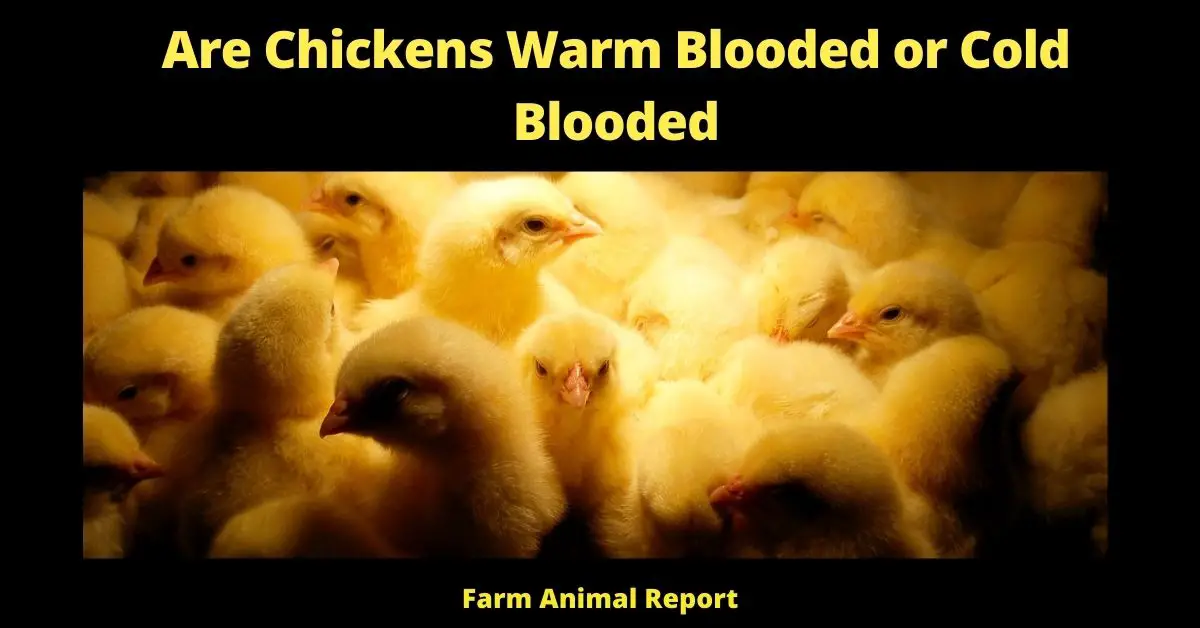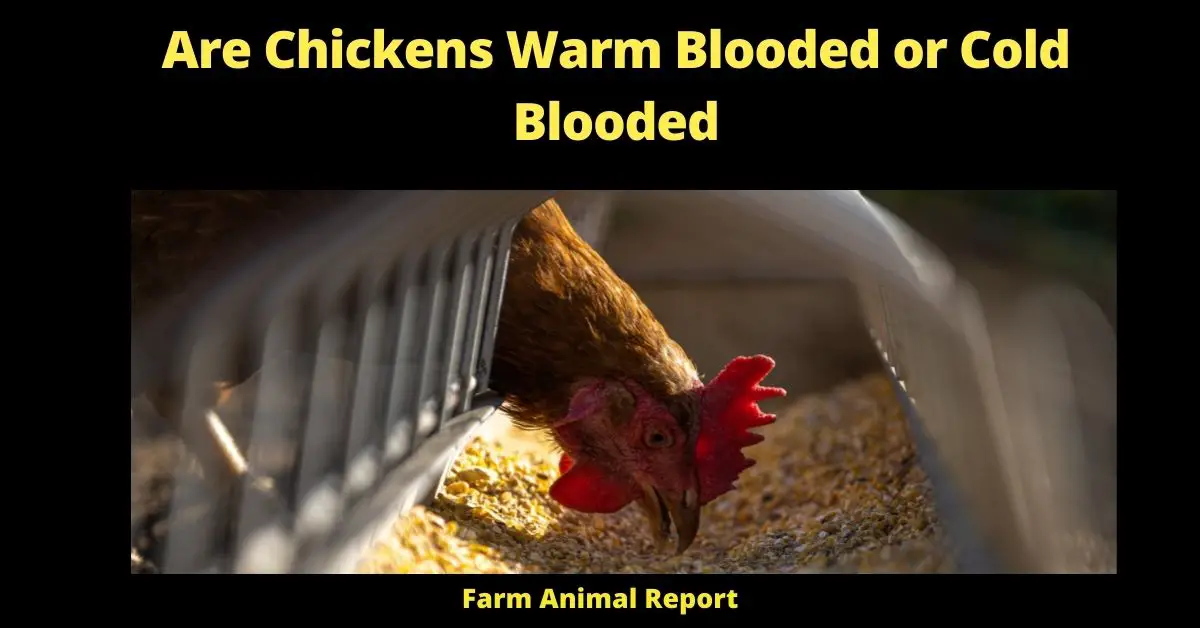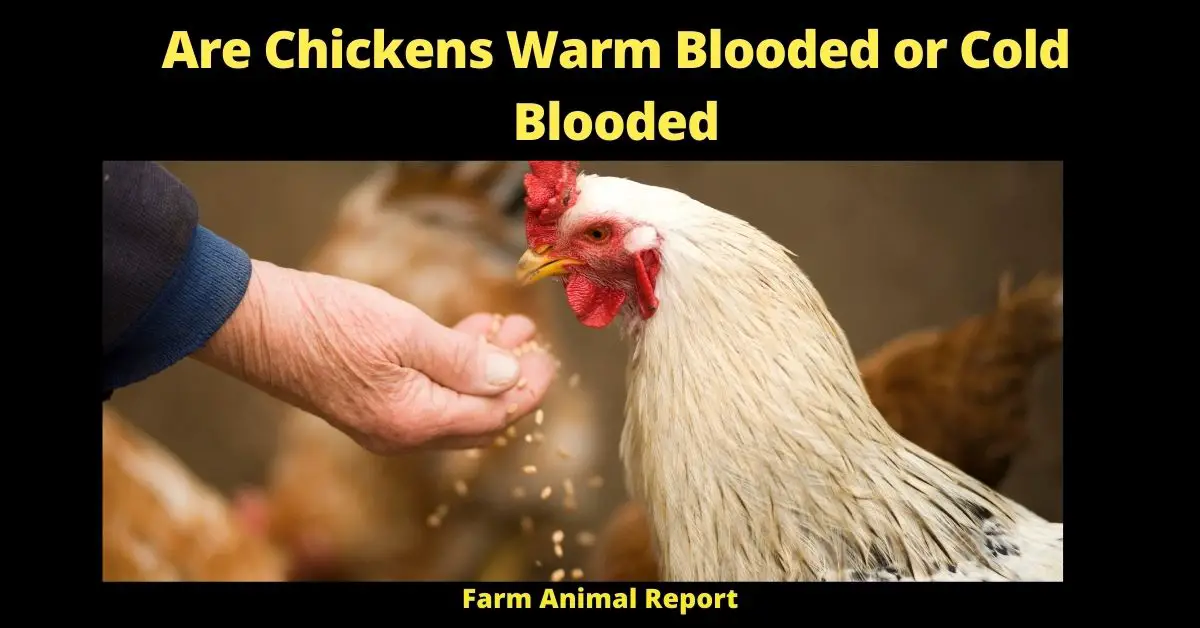While all of these characteristics are interesting, you might be wondering if chickens are warm-blooded. The answer is yes!
Are Chickens Cold Blooded?
Do you know if chickens are warm-blooded? A lot of people aren’t sure, but the answer is yes – chickens are warm-blooded animals. This means that they generate their own body heat and can maintain a relatively consistent internal temperature. In this blog post, we will discuss some of the things that make chickens warm-blooded creatures, as well as how this affects their everyday lives.
What Are the Different groups of Animals in the Animal Kingdom
Cold-Blooded animals – these animals rely on their environment to regulate their body temperature. This group includes reptiles, amphibians, and some fish. Jump to 12 Ways to Make Money by Chicken Farming **CHARTS**
Warm-Blooded Animal species – these animals generate their own body heat and can maintain a relatively consistent internal temperature. This group includes mammals and birds. Are Chickens Cold Blooded?
Check Out Amazon for Educational Resources for Breeding Chickens
What are the main differences between the Two Groups?
The biggest difference between cold-blooded and warm-blooded animals is how they regulate their body temperature. Cold-blooded creatures, like reptiles, can’t generate their own body heat. This means that they’re dependent on external sources of heat, such as the sun, to raise their internal temperature. In contrast, warm-blood animals maintain a relatively constant internal temperature regardless of the external environment. Chickens are able to do this because they generate their own body heat through metabolism.

Some of the Common Characteristics of Mammals are:
- Mammary glands,
- Hairy coats, three middle ear bones, and the ability to produce milk.
- Three-chambered heart
Some of the Common Characteristics of Birds are:
- Birds are warm-blooded, meaning they can maintain a constant body temperature regardless of the external environment
- Most birds have feathers, which provide insulation and keep them warm.
- Birds also have two ovaries, while mammals have only one.
- Additionally, birds have a four-chambered heart,
- Finally, birds typically have beaks instead of teeth.
- These characteristics are just some of the ways in which birds differ from other animals
Are Birds Mammals? Are Chickens mammals?
There is a lot of debate over whether birds are mammals or not. The answer to this question is not black and white, as there are some features that both groups share, and other features that set them apart.
One similarity between birds and mammals is that they are both vertebrates. This means that they have a backbone, which gives them stability and allows them to move around easily. Another similarity is that both groups have hair on their bodies- although the type of hair differs between birds and mammals.
Birds differ from mammals in a few key ways. Firstly, birds lay eggs, while mammals give birth to live young. Secondly, birds breathe through their lungs, while most mammals breathe through their noses. Finally,
Birds are warm blooded animals. They are the only class of vertebrates that have feathers. Birds are endothermic, meaning they generate heat from their own metabolism to maintain a constant body temperature. This is what allows them to fly in colder climates.
The audubon society is a Good Source of information on birds. They have a variety of resources that can help you learn more about these fascinating creatures.
What are the Stages of Chicken Growth
The Stages of Chicken growth are:
- Egg – A chicken egg is laid by a hen and contains the embryo of a chick.
- Chick hatches – After 21 days, the chick will hatch from the egg.
- Baby Chicks – Baby chicks are hatched chicks that are less than one week old.
- Young Chicks – Young chicks are hatched chicks that are between one and two weeks old.
- Young Chickens – Young chickens are hatched chicks that are between three and six weeks old.
- First week – During their first week, young chickens will learn to eat, drink, and walk. They will also start to grow feathers.
- Full Feathers – By the end of their eight week, most young chickens will have grown full feathers.
- Mature chicken– A mature chicken is a chicken that is more than six weeks old.
- Male chickens – Male chickens are called roosters. They have larger combs and wattles than female chickens.
- Female Chickens – Female chickens are called hens. They lay eggs and can be used for meat or egg production.
- Lay eggs – Hens will lay one egg every 24-26 hours.
- Adult chicken – An adult chicken is a chicken that is more than 12 weeks old.
- Senior Chicken – A senior chicken is a chicken that is more than 18 months old. Senior chickens typically do not lay as many eggs as younger hens.
What are Characteristics of Chicken/Part of the Fowl Family
Unique features are
- Hollow bones – Chickens have very light bones due to the fact that they are hollow. This makes them excellent flyers.
- Egg production – Chickens lay eggs, which are then used for food or hatching chicks.
- Toothless beaked jaws – Chickens have beaks instead of teeth, which helps them eat seeds and other small items.
- Combs – Chickens have a fleshy protuberance on their head called a comb. This is used to cool their body and attract mates.
- Wattles – Chickens have a fleshy protuberance on their neck called a wattle. This is used to attract mates.
- Beak – Chickens have a beak, which is used for eating and preening feathers.
- Body – Chickens have a body that is covered in feathers. The feathers are used for insulation and flight.
- Legs – Chickens have two legs, which they use for walking and perching.
- Wings – Chickens have two wings, which they use for flying and balance.
- Tail – Chickens have a tail, which they use for balance while flying.
- Claws – Chickens have claws on their feet, which they use for perching and scratching.
- Male chickens are called roosters and female chickens are Hens
How Does a Chickens Respiratory System Work?
A chicken breathes in air through its beak, and the air travels down its trachea to its lungs. The chicken then breathes out carbon dioxide through its beak. Chickens have a two-chamber system in their lungs, which helps them breathe more efficiently while flying.
The respiratory system is responsible for bringing oxygen into the body (air Sacs) and removing carbon dioxide. It includes the nose, mouth, throat, larynx, trachea, bronchi, and lungs.
Warm air is needed for the bird to be able to fly, so they have a specially adapted respiratory system that helps keep their body temperature high. Their lungs are also very efficient at exchanging carbon dioxide for oxygen, which is why chickens can breathe even when they’re running around.
Chickens have a special type of cell in their respiratory system called cilia cells. These cells help move mucus and dirt out of their lungs.
The cilia cells are tiny, hair-like structures that wave back and forth to move things along the respiratory tract. Mucus is a sticky substance that traps bacteria and other particles. The cilia cells wave the mucus towards the throat where it can be swallowed or coughed up and spit out.
Chickens also have a type of immune cell called macrophages. These cells eat bacteria and other harmful particles in the lungs. This helps keep the chicken’s respiratory system clean and free from infection.
The respiratory system works together with the circulatory system to provide oxygen to all the cells in the body. The circulatory system carries blood throughout the body
How does a Chickens Body temperature System Work?
- Chickens Body Temperatures – Chickens maintain a constant body temperature by using their respiratory and circulatory systems.
- Environmental temperature – Chickens adapt to the environmental temperature by adjusting their body temperature.
- Own body temperature – Chickens regulate their own body temperature by controlling blood circulation.
- Blood circulation – Chickens use their heart and blood vessels to circulate blood throughout their bodies.
- High body temperature – A high body temperature can be fatal for chickens.
- Chickens have a unique system that allows them to maintain a constant body temperate despite changes in the environment. Their respiratory and circulatory systems work together to control blood flow and keep the chicken’s internal organs at a consistent temperature.
How do Chickens Generate Body Heat?
- Chickens generate body heat through their metabolism. This is the process by which they convert food into energy. As they break down food molecules, they produce heat as a by-product. This internal heat helps to maintain their body temperature at a consistent level, even in cold weather.
- Chickens’ constant body temperature – Chickens maintain a constant body temperature of around 106 degrees Fahrenheit.
- Absolute body temperature – The absolute body temperature is the highest possible temperature that a chicken can reach without dying.
- Deep body temperature – The deep body temperature is the lowest possible temperature that a chicken can reach without dying.
- Normal body temperature – The normal body temperate for a chicken is between the absolute and deep body temperatures.
- Comfort zone – The comfort zone is the range of temperatures in which chickens are most comfortable. It is between 100 and 102 degrees Fahrenheit.
- Heat loss – Chickens lose heat through their feet, legs, beak, and feathers. They also lose heat through evaporation when they breathe out and sweat.
- Ambient temperature – The ambient temperate is the temperature of the environment in which a chicken lives.
- Internal body temperature – The internal body temperature is the temperature of the organs and tissues inside a chicken’s body.
- Higher body temperatures – Chickens can have higher body temperatures if they are sick or injured.
- Heat stress – Heat stress is when chickens become overheated and their body temperature rises to dangerous levels.
- Sweat glands – Chickens sweat through their skin to cool down their bodies.
- Defense mechanisms – Chickens use several defense mechanisms to protect themselves from heat stress, including panting, flapping their wings, and standing in water.
- environmental changes – Chickens use their respiratory and circulatory systems to adjust their body temperature in response to environmental changes.
- own body heat – Chickens generate their own body heat through their metabolism. This helps them maintain a constant body temperature, even in cold weather.

How to Keep Chickens Warm?
Some of the important items to help Keep Your Chickens warm are:
- Dry bedding – absorb body heat and help keep the chicken warm.
- Heat source – provide warmth to the chickens
- Heat transfer – help move heat from the chicken’s body to their environment
- Heat lamp – provide a consistent source of heat
- Drafts – can cause chickens to lose body heat
- Rain – can make the environment cold and damp, which can lead to hypothermia in chickens.
Chickens need Protection In Cold Weather / Colder Months
In Extreme Cold Chickens need to have protection in these individual conditions:
- Cooler climates – Chickens should be provided with a warm, dry place to sleep.
- Cold winter – Chickens should be provided with a heat source and extra bedding to keep them warm.
- Cold temperatures – Chickens should be given access to a warm spot where they can go to warm up.
- Extreme temperatures – In extreme temperatures, chickens should be kept inside in a temperature-controlled environment.
- Frozen ground – Frozen ground can cause frostbite in chickens. They should be given access to a heated area to prevent this from happening.
- Lower temperatures – Lower temperatures can cause respiratory problems in chickens. They should be given access to a heat source and extra bedding to keep them warm.
- Cold stress – Cold stress can cause death in chickens. They should be provided with a warm, dry place to sleep and a heat source to prevent this from happening.
- Outdoor temperature – The outdoor temperature can cause respiratory problems in chickens. They should be given access to a heat source and extra bedding to keep them warm.
- Optimal temperature – The optimal temperature for chickens is between 100 and 102 degrees Fahrenheit.
- Warm spot – A warm spot can provide warmth to the chickens when they need it.
- Hot weather – Hot weather can cause heat stress in. They should be given access to a cool, shady spot to prevent this from happening.
- Chickens use several defense mechanisms to protect themselves from the cold, including fluffing their feathers, huddling together, and standing on one leg.
- When it’s cold outside, chickens need a warm, dry place to sleep. They also need a heat source and extra bedding to keep them warm. If the temperature gets too low, chickens can get respiratory problems. So it’s important to provide them with a warm, dry place to sleep and a heat source. If the temperature gets too high, chickens can get heat stress. So it’s important to provide them with a cool, shady spot to prevent this from happening. Chickens are most
What are the Best Humidity for Chickens?
Chickens thrive in an environment with a relative humidity of 30 to 50%. High humidity can cause respiratory problems in chickens. So it’s important to provide them with a dry, well-ventilated place to sleep. If the humidity gets too high, chickens can get respiratory problems. So it’s important to provide them with a dry, well-ventilated place to sleep and a heat source. Chickens are most comfortable in an environment with a relative humidity of 30 to 50%. So it’s important to provide them with a dry, well-ventilated place to sleep.
How Fast is a Chickens Metababolism?
What factors govern that
- High Metabolism – need more food
- Low Metabolism – less food
Final Thoughts – Are Chickens Warm Blooded or Cold Blooded
Chickens are warm-blooded animals. They use several defense mechanisms to protect themselves from the cold, including fluffing their feathers, huddling together, and standing on one leg. Chickens need a warm, dry place to sleep. They also need a heat source and extra bedding to keep them warm. If the temperature gets too low, chickens can get respiratory problems.
So it’s important to provide them with a warm, dry place to sleep and a heat source. If the temperature gets too high, chickens can get heat stress. So it’s important to provide them with a cool, shady spot to prevent this from happening. Chickens are most comfortable in an environment with a relative humidity of 30 to 50%.






